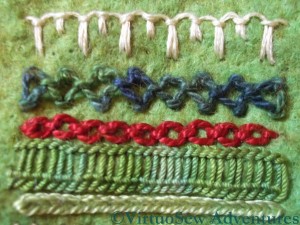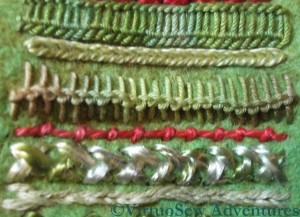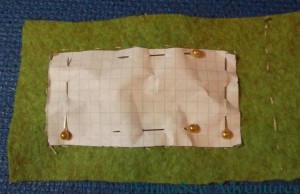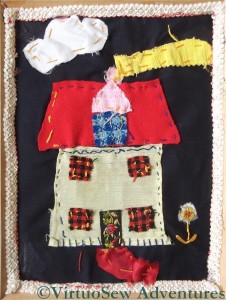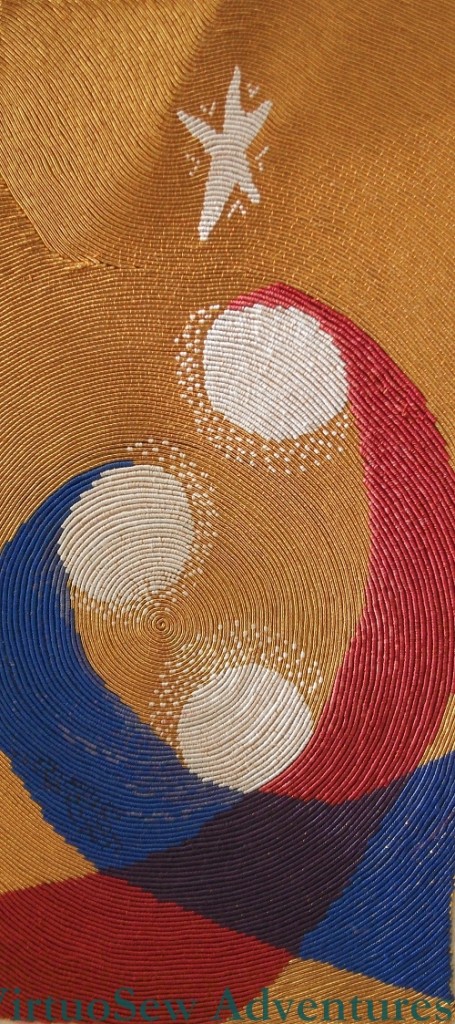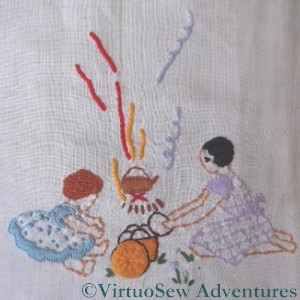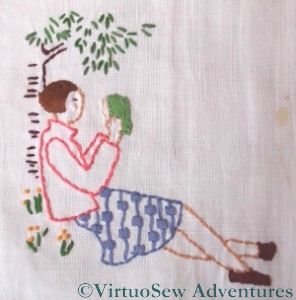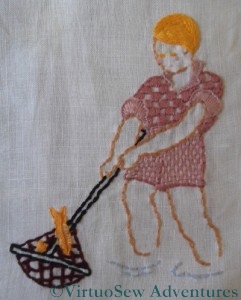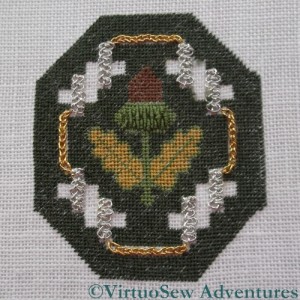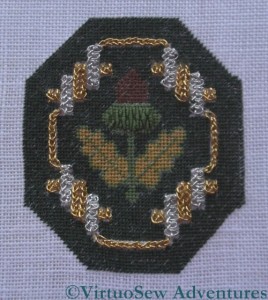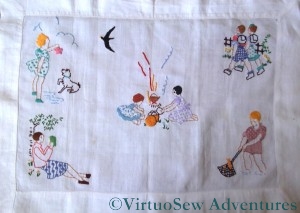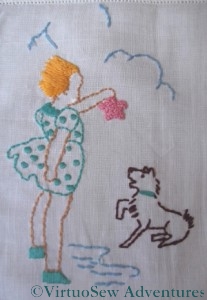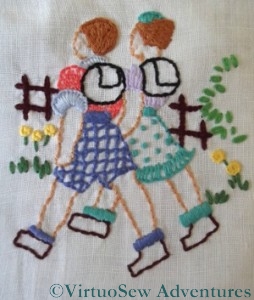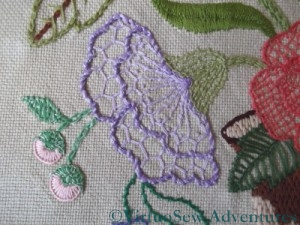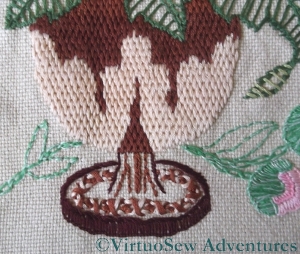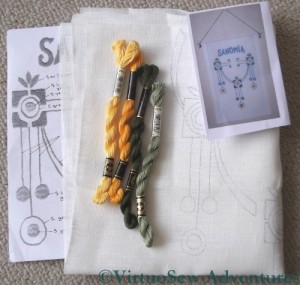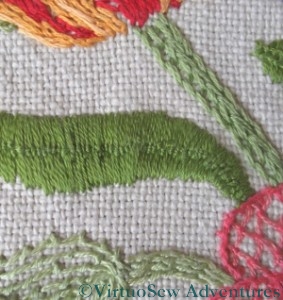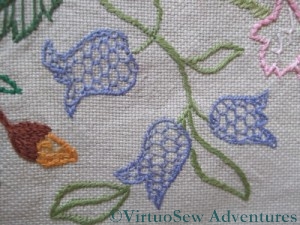Category: General Embroidery
Making It Up As I Went Along – Part Two
The idea of the sampler section was to give my cousin some inspiration for her own embroidery, and the chance to see what stitches look like in real life, since however good the book or the photo, it doesn’t come close to having the stitch there in front of you in real life! So I decided that it would consist of a sequence of stitches using a variety of threads. Naturally, I included some of my own favourite stitches!
Here, the top one is Up and Down Buttonhole Stitch, using a stranded linen thread from DMC. I first used this stitch in the Persian Fantasy, and I’ve loved it ever since. In this case I’ve added to the ornamental effect by alternating long and short upright stitches.
The next is Diamond Stitch, using an over dyed pearl cotton from Stef Francis. This is a stitch I’ve never used before but often wanted to. I’ll use it again, I’m sure – it was rather fun!
The third – in standard Anchor pearl cotton – is Cable Chain Stitch, which is my favourite chain stitch variation. It isn’t always suitable, because it is a stitch with a very strong character, and sometimes something more subtle is needed, but I always enjoy stitching it.
The fourth is Ladder Stitch, which I struggled with so much on the Tudor and Stuart Goldwork Masterclass course. Here I have used an overdyed soft cotton (Stef Francis again) and found it so much easier to do!
The fifth is Heavy Chain Stitch, which I have found very useful a number of times. It produces a smooth, clean line, definition without texture, which can be hard to achieve in embroidery, which after all is a very textural form of expression!
The first new stitch in this photo (sixth in the sampler panel) is Loop Stitch, this one in a round mercerised cotton. It’s another stitch I’ve not often used, but it provides a great contrast in texture with the Heavy Chain Stitch above it.
Stitch number seven is Coral Stitch (remember I used it for the little girl’s hair in the Holiday Traycloth?). I used another overdyed pearl cotton – one of my favourite threads, because it brings stitches to life.
Closed Herringbone Stitch is next, using an almost untwisted rayon thread. This produces a dense plaited effect – very glossy and dramatic.
The final row in this second photograph, number nine in the sequence, is a combination of Stem Stitch set beside Outline Stitch. I know it looks a lot like chain stitch, but the two stitches are mirror images of one another!
Making It Up As I Went Along – Part One
Since Christmas is over and the present duly received, I can at last show you the present I made for my cousin. She’s become interested in embroidery, and when I saw some hand made, beautifully-finished wooden tools (a mellor and a stiletto) at the Knitting and Stitching Show in Harrogate, I decided that I would give them to her for Christmas.
That was all well and good, but I couldn’t think of a suitable way to present them, so I decided to make a case for them. I spent some time sat in the picnic area at the show, sketching different possibilities and trying to work out what other supplies I needed to buy, and when, between mid-November and Christmas Day, I would be able to make it since I was still suffering from tennis elbow (I still am, but not nearly as much!). I was beginning to threaten to put together a kit and giving her that when one of the other ladies at the table pointed out that I would still need to make one as a proof of concept (a phrase I never expected to hear at the Knitting and Stitching Show!). She was right, because it evolved considerably in the process!
In the end I decided to make a case with three panels, using two layers of felt. I drew out paper patterns for each panel, and pinned them on to the piece of felt I had decided to use. I had considered putting a panel of canvaswork stitches on the front – I even bought a piece of congress cloth to use – but then decided that since she is interested in embroidery, it should be a panel of embroidery stitches.
As you can see, I also had second thoughts about the size of the sampler panel, and made it slightly smaller. That meant that there would be a wider border around the panel – always an improvement!
I ran tacking stitches around all the design elements to make sure I knew what was where, and then started thinking about the stitches to use for the sampler panel.
My Very First Appliqué
Rummaging in the archives is a very salutary experience. This indescribable piece of appliqué is the first embroidery I did without guiding holes in the fabric (like the little mat I described in an earlier post). I remember starting it when I was visiting a friend – it was a rainy day, and I think her mother was at her wits’ end with us. She sat us down with fabric, needle and thread, and (I suspect) prayed for peace and quiet..
Even though the stitches are dog-legged and the colour choices leave a lot to be desired, the piece still reveals things about Rachel-the-Stitcher that I recognise today. One side of the piece for the house is sewn down with blanket stitch, two with running stitch, and one with zigzag back stitch. You can take that two ways – either as evidence of my butterfly mind, never sticking to a single method, or as evidence that even then I was thinking about the implications of a stitch. Blanket stitch is a good “grounding” stitch, because of the combination of uprights and horizontals, and the zigzags are rather reminiscent of the wavy edges of some roof tiles.
The tweeds chosen for the windows and the pattern-woven braid for the door also show early signs of thinking about what I’m doing – the square patterns of the tweed recalling leaded windows and the pattern-woven braid creating a different texture for the entrance.
The braid edging glued to the frame is also symptomatic of a tendency to over-complicate, which I’ve not eradicated to this day. I think I keep it under control, but that is all I’ve managed to do…
Incidentally, like all those little girls of long ago, working on samplers with their governesses, unaware that students of social history and students of needlework would be poring over their work in the future, I noted on the back when I finished the piece – 30th September 1975. Unlike most of those little girls, I also noted – in so many words – that “It was fun.”
Holiday Traycloth – second installment
Now this is very “Swallows and Amazons“, isn’t it!
There’s a woven spiders web wheel for the top of the picnic basket, the little girl’s red hair is worked in coral stitch and her older sister’s is satin stitch. It’s barely visible in the photo, but the satin stitch is angled this way and that to create something that looks a little like a Marcel wave – a very grown up style on a relatively young girl!
As in the first installment, the cuffs and flounces are in blanket stitch. The spots are French knots, and the lilac dress is worked as a pattern of back stitches.
This motif, “Reading” shows particularly clearly how skilled the designer was in making the best possible use of simple shapes and simple line. Much of the design uses straight stitches – for the leaves, the bark, and the stems of the leaves.
The pattern on the skirt alternates back stitches with tiny satin stitch blocks, and the hair is stem stitch. The book and the shoes are satin stitch, the flowers are French Knots, and anything else is in back stitch.
It couldn’t be simpler to do, but doesn’t it look good!
This is the point where – after nobly containing my experimental impulses for quite some time! – I indulged in a few wanderings from the path laid down. The shorts are actually woven! It must have been tricky to get right, but it’s worked really well – they look slightly tweedy, but in any case the sort of heavy fabric that any sensible mother would clothe her child in for scrambling around rocks and beaches.
The little gold fish is worked in Vandyke stitch, which is tricky to keep even but creates a strong line down the side of the fish to contrast with the net in the background.
Dealing with the Golden Acorn
You last saw the Golden Acorn in July, when I was thoroughly fed up with it.
Since I’d got so engrossed in stitching that I’d neglected to pay attention to the details and had to unpick the lot, when I came to re-stitch I decided to put in the braid stitch in silver first.
I found the silver to be a more temperamental thread than the gold, although structurally it was exactly the same. However, these threads are all made more or less by hand, and must be hugely susceptible to temperature and humidity.
I know from my textile technology studies that natural fibres – such as cotton, wool, and silk – are susceptible to environmental conditions, because the basis for the success of the Lancashire cotton industry was due in no small part to the fact that ideal conditions for growing cotton are far from ideal for turning the cotton into cloth. In fact, nowadays, textile factories are built with climate control, because the speed of modern production demands that all possible variables be thoroughly ironed out.
In the same way, if you visit a woollen mill, you will see piles of wool at various stages of production, just sitting there. If you are a time-and-motion person you’ll get very uptight about this, and talk about “Just In Time” manufacturing – only to be told, in no uncertain terms, that if you want to pay for all the failed batches that will result from not allowing the wool to relax (technical term – yes, honestly) between processes, you’re welcome, but the manager won’t let it out of the factory with their name on it.
The silver and gold threads we are using have natural fibre cores, so sensitivity to climate is only to be expected!
I found both of the two main stitches in the strapwork, Ceylon stitch and Braid Stitch, rather troublesome in metal thread, although Braid Stitch in pearl cotton is one of my favourites. There’s no denying that they produce a rich and exotic effect once they are in place, though!
I became slightly fed up with tent stitch – there was such a lot of it! – while I was working this, so I’ve been giving myself some time away from it. I’ll get started on the next one of these when I feel ready for fine tent stitch again.
I’m also waiting until all three are stitched before I decide which to finish to create which stitching accessory. If I recall correctly, there’s a scissors keep, a needlecase, and a pincushion. I suspect they’ll end up in that famous Winter Decoration Corner I keep threatening to do!
Holiday Traycloth – first installment
I worked this immediately after the First Voluntary Project, and my goodness, is there a difference between the two! I think I must have talked with Grandmama and looked at some of her embroidery, and it looks as though suddenly the whole idea “clicked”.
The motifs are from transfers from another of Grandmama’s Needlewoman Magazines (August 1934, if you are interested!), worked on an old piece of linen in stranded cottons. The design was suggested to be a cover for a photograph album, but since my family isn’t really photograph-conscious, I felt that such a thing would be superfluous, and finished it as a traycloth instead. We added the seagull to cover a hole in the linen, which was already quite old.
The range of stitches is very limited on this piece – I must have been following the instructions in the magazine – and the whole thing is surprisingly neatly worked. I love the little girl’s spotty dress (satin stitch spots!) and windswept stem stitch hair, and the starfish is wonderfully knobbly, with closely packed French knots.
Most of the outlining across the whole piece is in back stitch, and although I didn’t count it precisely, I suspect the weave of the linen made that much easier to do than it might have been.
The designs themselves are very reminiscent of the children’s books of the period – it’s even exactly the right sort of dog, slightly scruffy, but always ready to play!
These walkers have blanket stitch collars and cuffs, and stem stitch hair. His shorts are worked in Jacobean Couching and the spots on her skirt are French knots. The leaves on the bush in the background are detached chain, and the yellow flowers are blanket stitch wheels. Again, the hair is in stem stitch and the socks (like the little girl’s shoes) are in satin stitch.
You’ll notice that all of these stitches re-occur when I describe the other motifs, too. The designer has made absolutely first-class use of all the stitches.
First Voluntary Project – Fifth Installment
This chrysanthemum is outlined, like the other, in Whipped Stem Stitch, but in this case the filling is Cretan Stitch, quite widely spaced. I rather like the slightly rippling effect this creates, but the stitches perhaps needed to be just a little more closely packed to make the ripple a bit stronger. The calyx is rows of coral stitch, and the stems of those strange little buds are the very first appearance in my work of one of my favourite stitches – Cable Chain Stitch.
The vase is worked in Brick Stitch, and since the fabric is a heavy square weave it was easy to do as a counted stitch – easier than when I worked the Prince’s Steed in the Persian Fantasy!
The foot of the vase is in closely-packed blanket stitch, and the ornamentation is Whipped Chain Stitch. I think if I were to be working it like this now, I would continue the brick stitch down the stem of the vase and leave out the whipped chain. But after all, it was my first solo project…
Naturally this won’t be going on display anywhere, but it’s been fascinating to revisit it, and try to remember what I chose and why. There wasn’t much of the why, but I’ve enjoyed looking at my experiments, anyway!
Finnish Embroidery
A few weeks ago, my husband the Australian was speaking at a conference in Turku, Finland, and the organisers were kind enough to allow me to go too. We had a marvellous time – the Finns are terrifyingly good linguists, so we had no language problems, and because the conference was about Science and Art, and how they feed off one another and contribute to one another, the conversations were very wide-ranging, full of sparkle and fun.
I didn’t have much time for side trips, but I did find an embroidery shop, and asked about local rural Finnish embroidery. I picked a design I liked the look of, and they agreed to prepare a tracing for me and send it on. It seems to be in a combination of stem stitch and Bokhara couching, but when I’ve had a closer look at the stitch diagrams, I will be able to tell you more.
This is what the lady in the shop told me about the design:
You also asked for some information about the pattern, we have a book that tells a brief history of where the pattern was found. Of course, the original designer of the pattern is impossible to trace.
The pattern was originally embroidered on a bag or pouch, that was hanged on the wall, where people put smaller newspapers and magazines into. That’s why the pattern is called ”Sanomia”, it means messages or news in finnish. The word was also embroidered in the bag. We copied the model ourselves to other products, such as runners.
The ”Sanomia”-newspaper bag was found in the Kankaristo house, in country village of Mynämäki.
The bag, that was found there, was sewn by the lady of the house, Helli Kankaristo, born in 1902. The story tells that she was taught to make embroideries by her very skillful teacher at school, and Helli passed her skills also to daughter Inkeri, born in 1928.
First Voluntary Project – Fourth Installment
This long leaf is worked in Bokhara Couching. I find it strange that it did not occur to me at the time that this stitch is as near to satin stitch as makes very little difference! It isn’t particularly neat, in fact it is even rather crammed together, but it serves a purpose, and the stitch is a useful one to know.
I’ve seen diagrams that refer to this as “Roumanian couching” and “Romanian Stitch” , as well as Bokhara couching, which can make life confusing at times.
I’m now using it on the Finnish Embroidery, stitched in pearl cotton – it creates a lovely “basketlike” texture.
The bluebells are outlined in stem stitch and then filled with Cretan stitch, carefully spaced to create a sort of honeycomb effect. I rather like this, and I’m sad to say that I’ve not used it very much since. It’s good to be reminded of it, and I will try to use it again! The stems are worked in stem stitch, although angled to create a much thicker line than is normal – another effect I rather like, but rarely use.
The golden yellow bud is filled with Ceylon Stitch, which I found myself using in the Goldwork Masterclass, while the calyx is chain stitch again. The Ceylon stitch is the only one which has suffered from the passage of time, but since it was worked in a single strand, that’s scarcely surprising!

